Edenia gomezpompae M.C. González, Anaya, Glenn, Saucedo & Hanlin, Mycotaxon 101: 254 (2007). Figs 129, 130
MycoBank number: MB 510944; Index Fungorum number: IF 510944; Facesoffungi number: FoF 06588.
Saprobic on decaying twigs. Sexual morph: Ascomata 236–250 × 335–372 µm perithecial, scattered, immersed, coriaceous, globose to subglobose, unilocular, papillate, with centrally ostiolar necks, 115 × 93 µm, periphysate. Peridium 27 µm wide, outer layer composed of textura porrecta cell layers and inner layers composed of pale brown textura angularis cell layers. Hamathecium 4.2 µm wide at base, narrow towards apical end, filamentous, septate, unbranched, pseudoparaphyses, embedded in a gelatinous matrix. Asci (124–)130–185 × 29–36 µm (x̅ = 148 × 31.7, n = 10), 8- spored, bitunicate, fissitunicate, clavate, apically obtuse with a distinct ocular chamber, short pedicellate. Ascospores (23–)26.5–32 × 12.5–16 µm (x̅ = 32.8 × 16.2, n = 25), overlapping 1–2- seriate, initially hyaline, becoming brown to reddish brown with hyaline to pale brown end cells, with mammiform apices, broadly fusiform to ellipsoidal, 1-septate, slightly constricted when young, large guttules in each cell, verruculose. Asexual morph: Pycnidia on culture plates, 230–310 × 210–300 µm, globose, centrally verruculose, ostiolate necks, 25 µm with long brown spinous setae, setae 100–130 µm, covered below with brown mycelium, outer textura subglobosa and inner textura intricata. Conidia 3.5–5.3 × 1.5–2.1 (x̅ = 4.4 × 1.8) µm, hyaline, fusiform, obtuse ends, smooth-walled.
Material examined – INDIA, Andaman and Nicobar Islands, South Andaman, Manjery, Nayashar (11˚34’50.4”N 92˚40’47.7”E), on unidentified decaying twig, 15 May 2018, M. Niranjan & V.V. Sarma, PUFNI 1879 (AMH-10083; Ajrekar Mycological Herbarium-AMH), living culture, NFCC-4435 (National Fungal Culture Collection of India (NFCCI), Agarkar Research Institute (ARI), Pune).
Notes – The isolate AMH 10083 has a close relationship with Edenia in Phaeosphaeriaceae. Edenia consists of two species E. achyranthis and E. gomezpompae (González et al. 2007, Sun et al. 2013). Edenia achyranthis was found on the stem of Achyranthes bidentata as an endophyte in Hebei, China (Sun et al. 2013). Edenia gomezpompae was isolated from leaves of Callicarpa acummata in Mexico (González et al. 2007) as an endophytic hyphomycete. Neither species produced a sexual morph. Phenotypic observations of E. gomezpompae have found that the colonies have sterile mycelium, hyphal branching at a 90 ‘angle and string-like strands on a PDA plate (Gonzalez et al. 2007). Edenia achyranthis grown on MEA showed the hyphomycetous asexual morph with synnemata bundles producing subhyaline, ellipsoidal conidia (Sun et al. 2013). Crous et al. (2009a) reported the hyphomycetous asexual morph of E. gomezpompae occurring on leaf spots of Senna alata and a synanamorph pyronellea-like coelomycete sporulated in culture and this collection was designated as an epitype of E. gomezpompae. Our isolate AMH 10083 has globose pycnidia rather than synnemata, and ellipsoid conidia. The conidia of isolate AMH 10083 have slightly smaller (3.5–5.3 × 1.5–2.1 µm) compared to E. achyranthis (3.5–6.1 × 1.7–2.5 µm; Sun et al. 2013) and the epitype of E. gomezpompae (11–)13–15(–16) × (3.5–)4.5–5.5(–6) µm; Crous et al. 2009a). However, the coelomycetous asexual morph of our isolate (AMH 10083) could not be compared with the epitype as Crous et al. (2009a) did not provide a description of the pyronellea-like coelomycete. Phylogenetically, isolate AMH 10083 clustered with E. gomezpompae (Fig. 127). Therefore, we identify our isolate as E. gomezpompae. This is the first report of the sexual morph of Edenia gomezpompae.
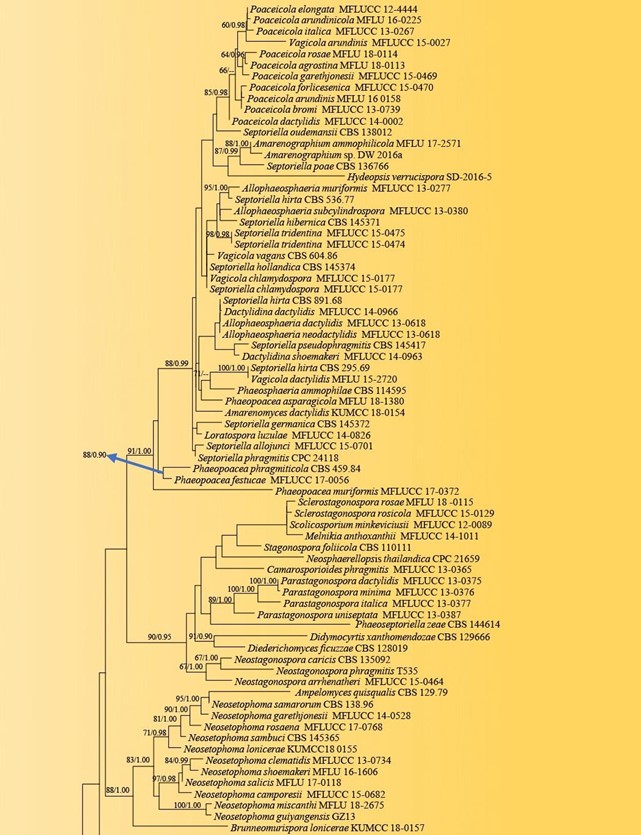
Figure 127 – Phylogram generated from maximum likelihood analysis (RAxML) of genera in Phaeosphaeriaceae based on ITS, LSU, SSU, and tef1 sequence data. Maximum likelihood bootstrap values equal or above 70 %, Bayesian posterior probabilities equal or above 0.90 (MLBS/PP) are given at the nodes. An original isolate number is noted after the species name. The tree is rooted to Leptosphaeria doliolum (CBS 505.75) and Paraleptosphaeria dryadis (CBS 643.86). Hyphen (-) represents support values below 70 % MLBS and 0.90 PP.
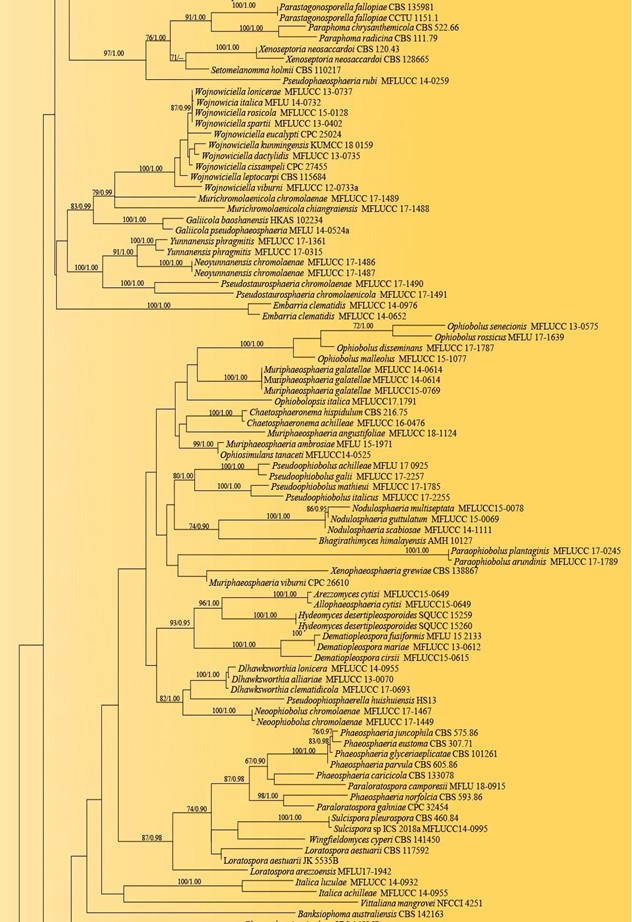
Figure 127 – Continued.
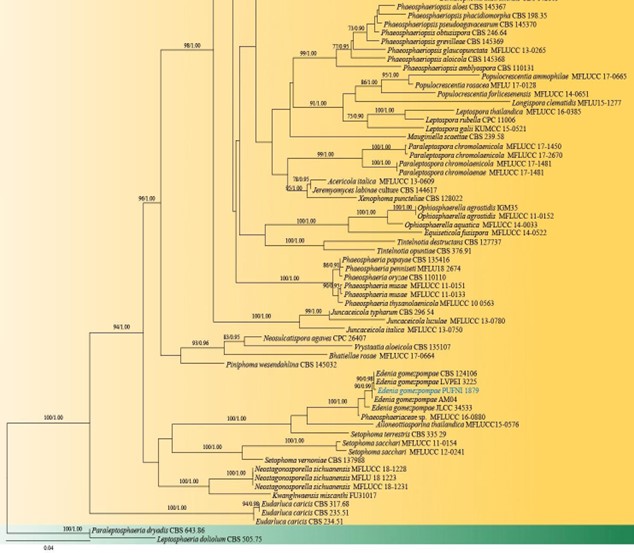
Figure 127 – Continued
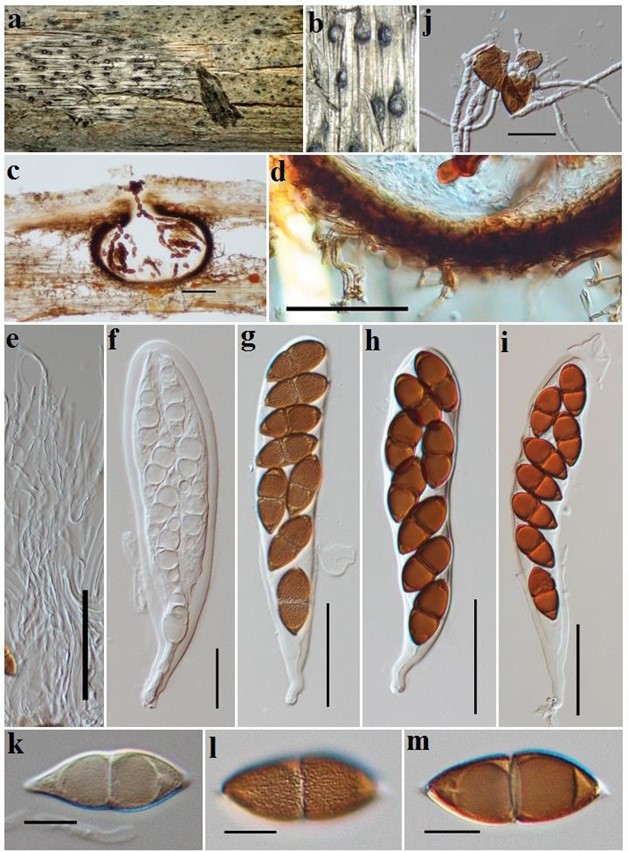
Figure 129 – Edenia gomezpompae (NFCC-4435). a, b Ascomata. c Section of ascoma. d Peridium. e Pseudoparaphyses. f–i Asci. j Germinating spore k–m Ascospores. Scale bars: c = 100 µm. d, e, g–i = 50 µm. h, j =20 µm. k–m = 10 µm.
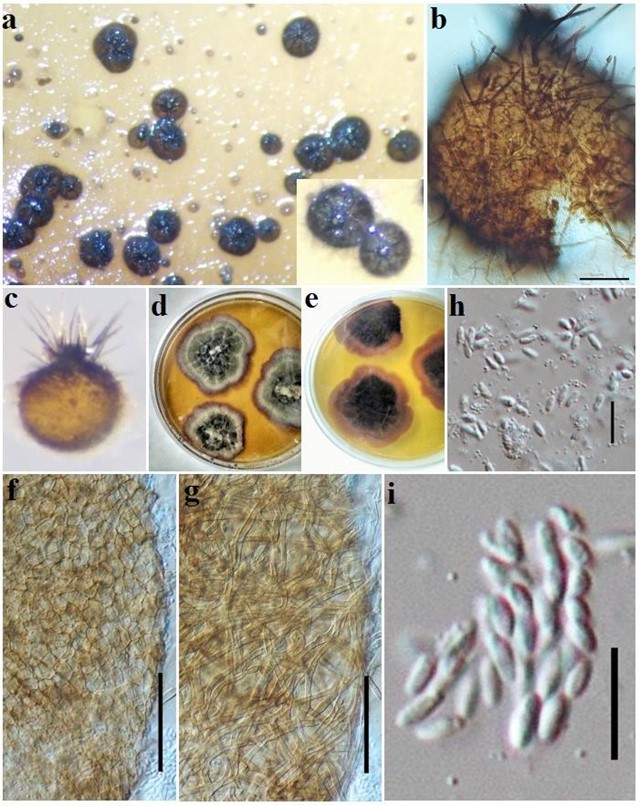
Figure 130 – Edenia gomezpompae (NFCC-4435). a Pycnidia on petri plate. b, c Pycnidium with spines and brown hyphae. d, e Culture on petri plates. f Textura angularis. g Inner wall textura intricate. h, i Conidia. Scale bars: b, f, g = 50 µm. h, i =10 µm.
